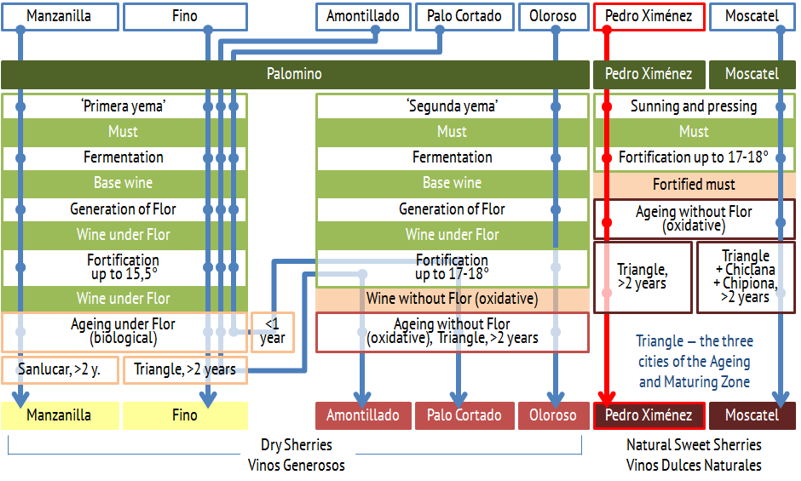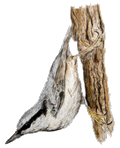
- Sherry Wine:
- Production
- Classification
- Cities & Bodegas
- Tastings
- Analogues
- Authors & Contacts
- Ðóññêèé ñàéò
Sherry wine types
Pedro Ximénez
Olga Nikandrova and Denis Shumakov.
Pedro Ximénez is a natural sweet sherry produced from raisined grapes of Pedro Ximénez variety and oxidatively aged.

There is one principle and banal and several technical things to know about Pedro Ximénez. The principle thing is that natural sweet sherries (Pedro Ximénez and Moscatel) are absolutely different from dry sherries. In fact they have only two moments in common: they are all sherries, and they are mostly aged in the Criaderas and Solera system. The rest — grape varieties, processing technologies, and the outcome — is different. Now to the technical things.
First, Pedro Ximénez is produced from the sun-withered grape of the same name. The must made from such grapes can hardly ferment on its own. So, almost all alcohol in Pedro Ximénez is the one added to the must during fortification. The must is fortified twice. First time (up to 10°)— for stabilization, the second time (up to traditional 17-18°) — before ageing.
Second, dynamical ageing of Pedro Ximénez lasts minimum two years and technologically is no different from oxidative ageing of other sherries. And, first of all, it is needed (in its dynamical part) for the wine to be constantly blended just as well.
That’s it. The end product is a think and sweet wine with a sugar content of 200 grams per liter and 15-22° alcoholic strength. Pedro Ximénez is dark (ebony) in color, when swirled in the glass it actively demonstrates “legs”. It has a rich, sensual aroma with predominant notes of dried fruits (here everything depends on personal background, but raisins, figs and dates are almost always there),with notes of honey, candied fruit, chocolate, coffee, cocoa and licorice. The wine’s texture is velvety and dense, the taste, naturally, is sweet. The aftertaste is long and encouraging further drinking.
The rules of the Regulatory Council allow using wine produced in the Montilla-Moriles Region for replenishing the last of criaderas when ageing Pedro Ximénez in the Jerez Region. In case there is a lack of own materials. This is not the issue to get disappointed about, since Pedro Ximénez is very good in Montilla-Moriles.
Pedro Ximénez can be the basis old sherries certified as V.O.S. or V.O.R.S. — that is sherries with average age of 20 and 30 years respectively. And other old sherries, of course.
The etymology of this sherry’s name is evident.

Pedro Ximénez and Ruby tea
in Izborsk. Idyll.
When choosing a glass for Pedro Ximénez, take into account that this sherry is usually consumed in small volumes. A traditional special sherry glass or an ITG would go, but even better would be something very small. A liqueur glass, for example. But if Pedro Ximénez is to served on the rock, or mixed with other drinks, the choice of the glass could be guided by cocktail reasons — spectacularity and convenience.
Traditional serving temperature for Pedro Ximénez is 12-14°C, but, as well as with other sherries, you can easily experiment (or just as easily ignore this recommendation). When Pedro Ximénez is strongly cooled, its notes of vanilla and menthol become more vivid. If you let it warm up to room temperature, notes of dried fruit will predominate.
There many desserts among Pedro Ximénez’s official “partners” — this sweet sherry rhymes perfectly with ice-creams, cheesecakes, chocolate, and other panna-cottas. You can just drink it along with these dainties or use it as a syrup to decorate and flavor them. Pedro Ximénez also pairs well with contrasting dishes and products — such as Mexican chili or blue cheeses. On the same contrasting principle (here we go beyond the Regulating Council recommendations) sweet sherry can be combined with salty dried fish, with our Pepsi Lake smelt for example. And, of course, Pedro Ximénez is a good company for black tea. Like this for example.
Pedro Ximénez is the main cause of the wide-spread stereotype about sherry as about the wine which can be only sweet. It’s a good stereotype, because sticking to it is sweet, but destroying it is also a new pleasure.
Pedro Ximénezes reviewed on the website (in Russian only):
— Lustau Pedro Ximénez San Emilio
— Barbadillo Pedro Ximénez La Cilla
— González Byass Nectar Pedro Ximénez
— González Byass Noé
— Alvear Pedro Ximénez Solera
— Colosia Pedro Ximénez
— Don PX Gran Reserva 1982
— Pedro Ximénez El Candado
— Pedro Ximénez Alexandro
— S' PX Solera 1989
— Osborne Pedro Ximénez 1827
Read next — Moscatel.
Warning!
This site can contain information about drinks excessive consumption of which may cause harm to health and is unadvisable for people who didn’t come of age.
Share Sherry
- Sherry.wine, FEDEJEREZ
- Copa Jerez, Sherry Week
- Sherry Notes, Jerez de Cine
- Los Generosos, Criadera
- Jerez-Xeres-Sherry
- Los Vinos de Jerez
Articles
- There are more articles in Russian than in English in this website. Sorry :(
Reviews
- To our great regret, we didn’t have time to translate tasting and traveling notes into English. But, if you want, you can see them in Russian.

